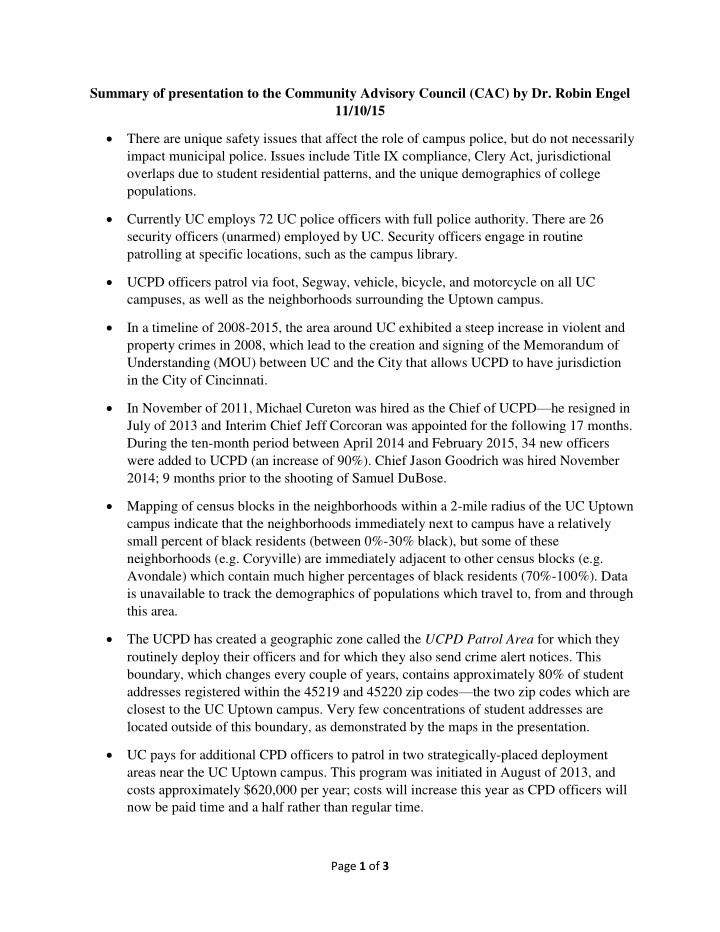



Summary of presentation to the Community Advisory Council (CAC) by Dr. Robin Engel 11/10/15 There are unique safety issues that affect the role of campus police, but do not necessarily impact municipal police. Issues include Title IX compliance, Clery Act, jurisdictional overlaps due to student residential patterns, and the unique demographics of college populations. Currently UC employs 72 UC police officers with full police authority. There are 26 security officers (unarmed) employed by UC. Security officers engage in routine patrolling at specific locations, such as the campus library. UCPD officers patrol via foot, Segway, vehicle, bicycle, and motorcycle on all UC campuses, as well as the neighborhoods surrounding the Uptown campus. In a timeline of 2008-2015, the area around UC exhibited a steep increase in violent and property crimes in 2008, which lead to the creation and signing of the Memorandum of Understanding (MOU) between UC and the City that allows UCPD to have jurisdiction in the City of Cincinnati. In November of 2011, Michael Cureton was hired as the Chief of UCPD — he resigned in July of 2013 and Interim Chief Jeff Corcoran was appointed for the following 17 months. During the ten-month period between April 2014 and February 2015, 34 new officers were added to UCPD (an increase of 90%). Chief Jason Goodrich was hired November 2014; 9 months prior to the shooting of Samuel DuBose. Mapping of census blocks in the neighborhoods within a 2-mile radius of the UC Uptown campus indicate that the neighborhoods immediately next to campus have a relatively small percent of black residents (between 0%-30% black), but some of these neighborhoods (e.g. Coryville) are immediately adjacent to other census blocks (e.g. Avondale) which contain much higher percentages of black residents (70%-100%). Data is unavailable to track the demographics of populations which travel to, from and through this area. The UCPD has created a geographic zone called the UCPD Patrol Area for which they routinely deploy their officers and for which they also send crime alert notices. This boundary, which changes every couple of years, contains approximately 80% of student addresses registered within the 45219 and 45220 zip codes — the two zip codes which are closest to the UC Uptown campus. Very few concentrations of student addresses are located outside of this boundary, as demonstrated by the maps in the presentation. UC pays for additional CPD officers to patrol in two strategically-placed deployment areas near the UC Uptown campus. This program was initiated in August of 2013, and costs approximately $620,000 per year; costs will increase this year as CPD officers will now be paid time and a half rather than regular time. Page 1 of 3
Each night, between the hours of 7 PM and 3 AM, CPD District Four staffs 3 officers and 1 supervisor and CPD District Five staffs 7 officers and 1 supervisor for this additional detail – a total of 12 additional police officers every night. These patrols are supplemental to the normal CPD police patrols which routinely occur from the City. Violent crime incidents from the past 10 years (2004 to 2014) reported to the CPD in the areas around UC (UCPD Patrol Area) show large numbers of crime incidents and victims between 2004 and 2008. However, crime began to decline in 2009 (coinciding with the MOU between UCPC and CPD) and has continued to steadily decline every year since. A similar decline was shown for property crimes reported to CPD, but the decline is not as steep as that for violent crime. The presentation includes visual displays of the UCPD traffic report released to the media in August 2015 (also attached to CAC email). Trends show an increase in the number of traffic stops made by UCPD between 2012 and 2015. There was also an increase in the number of stops which resulted in a citation made by UCPD. The number of stops which resulted in an arrest remained relatively stable between 2012 and 2015. Dr. Engel discussed the nuances of the data and the difficulty associated with interpreting these trends. The number of individuals cited by UCPD increased substantially annually between 2012 and 2015, but this did not occur for the number of individuals arrested. These trends are also reflected in the number of citations issued and the number of arrest charges given by UCPD. Line graphs depicting the percentage of each race of individuals who were cited by UCPD over time, indicate that the percentage of black individuals who were cited and arrested both increased between 2012 and 2015. Comparisons to an appropriate benchmark (e.g., the number of traffic violators in the area by race) are not available. Reported violent and property crime from July 19- November 3 of this year is down compared to the same time periods in previous years. Restricting the use of off-campus traffic stops by the UCPD does not appear to have reduced public safety in the UC Patrol Area . Previous Reform Efforts: • Independent investigation of incident (both CPD and Kroll, Inc.) • Hired team of experts • Implementation of Early Warning System • Changes in data collection • Addition of street-level supervision Recent Reform Efforts: • Training in Fair and Impartial Policing Page 2 of 3
• Creation of Community Advisory Council (CAC) • Working with CUF & Corryville Community Councils • RFP for independent comprehensive review of the UCPD • Short-term and long-term plans for diversifying the UCPD • Ongoing community outreach, healing conversations, demonstrations, forums on campus • Revisions of the MOU with the City Page 3 of 3
Recommend
More recommend